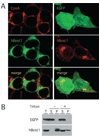Structure-function analysis of the bestrophin family of anion channels
- PMID: 12907679
- PMCID: PMC2885917
- DOI: 10.1074/jbc.M306150200
Structure-function analysis of the bestrophin family of anion channels
Abstract
The bestrophins are a newly described family of anion channels unrelated in primary sequence to any previously characterized channel proteins. The human genome codes for four bestrophins, each of which confers a distinctive plasma membrane conductance on transfected 293 cells. Extracellular treatment with methanethiosulfonate ethyltrimethylammonium (MTSET) of a series of substitution mutants that eliminate one or more cysteines from human bestrophin1 demonstrates that cysteine 69 is the single endogenous cysteine responsible for MTSET inhibition of whole-cell current. Cysteines introduced between positions 78-99 and 223-226 are also accessible to external MTSET, with MTSET modification at positions 79, 80, 83, and 90 producing a 2-6-fold increase in whole-cell current. The latter set of four cysteine-substitution mutants define a region that appears to mediate allosteric control of channel activity. Mapping of transmembrane topography by insertion of N-linked glycosylation sites and tobacco etch virus protease cleavage sites provides evidence for cytosolic N and C termini and an unexpected transmembrane topography with at least three extracellular loops that include positions 60-63, 212-227, and 261-267. These experiments provide the first structural analysis of the bestrophin channel family.
Figures








Similar articles
-
Conformationally sensitive residues in transmembrane domain 9 of the Na+/dicarboxylate co-transporter.J Biol Chem. 2001 Aug 10;276(32):29961-8. doi: 10.1074/jbc.M011387200. Epub 2001 Jun 8. J Biol Chem. 2001. PMID: 11399753
-
The anion-selective pore of the bestrophins, a family of chloride channels associated with retinal degeneration.J Neurosci. 2006 May 17;26(20):5411-9. doi: 10.1523/JNEUROSCI.5500-05.2006. J Neurosci. 2006. PMID: 16707793 Free PMC article.
-
Determinants of anion permeation in the second transmembrane domain of the mouse bestrophin-2 chloride channel.J Gen Physiol. 2004 Oct;124(4):371-82. doi: 10.1085/jgp.200409108. J Gen Physiol. 2004. PMID: 15452198 Free PMC article.
-
Molecular physiology of bestrophins: multifunctional membrane proteins linked to best disease and other retinopathies.Physiol Rev. 2008 Apr;88(2):639-72. doi: 10.1152/physrev.00022.2007. Physiol Rev. 2008. PMID: 18391176 Review.
-
Emerging issues of connexin channels: biophysics fills the gap.Q Rev Biophys. 2001 Aug;34(3):325-472. doi: 10.1017/s0033583501003705. Q Rev Biophys. 2001. PMID: 11838236 Review.
Cited by
-
The role of the Notch signalling pathway in the pathogenesis of ulcerative colitis: from the perspective of intestinal mucosal barrier.Front Med (Lausanne). 2024 Jan 5;10:1333531. doi: 10.3389/fmed.2023.1333531. eCollection 2023. Front Med (Lausanne). 2024. PMID: 38249980 Free PMC article. Review.
-
A novel compound heterozygous BEST1 gene mutation in two siblings causing autosomal recessive bestrophinopathy.BMC Ophthalmol. 2022 Dec 16;22(1):493. doi: 10.1186/s12886-022-02703-5. BMC Ophthalmol. 2022. PMID: 36527004 Free PMC article.
-
Cytosolic domain regulates the calcium sensitivity and surface expression of BEST1 channels in the HEK293 cells.BMB Rep. 2023 Mar;56(2):172-177. doi: 10.5483/BMBRep.2022-0170. BMB Rep. 2023. PMID: 36593105 Free PMC article.
-
[Morbus Best].Ophthalmologe. 2005 Feb;102(2):109-10. doi: 10.1007/s00347-004-1156-4. Ophthalmologe. 2005. PMID: 15627201 Review. German. No abstract available.
-
Impaired Bestrophin Channel Activity in an iPSC-RPE Model of Best Vitelliform Macular Dystrophy (BVMD) from an Early Onset Patient Carrying the P77S Dominant Mutation.Int J Mol Sci. 2022 Jul 4;23(13):7432. doi: 10.3390/ijms23137432. Int J Mol Sci. 2022. PMID: 35806438 Free PMC article.
References
-
- Jentsch TJ, Gunther W. BioEssays. 1997;19:117–126. - PubMed
-
- George AL, Bianchi L, Link EM, Vanoye CG. Curr. Biol. 2001;11:R620–R628. - PubMed
-
- Hille B. Ion Channels of Excitable Membranes. Sunderland, MA: Sinauer Associates, Inc.; 2001.
-
- Iyer R, Iverson TM, Accardi A, Miller C. Nature. 2002;419:715–718. - PubMed
Publication types
MeSH terms
Substances
Grants and funding
LinkOut - more resources
Full Text Sources
Other Literature Sources
Molecular Biology Databases

